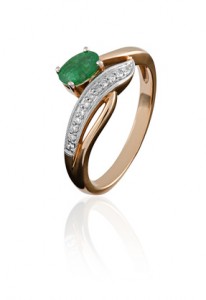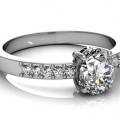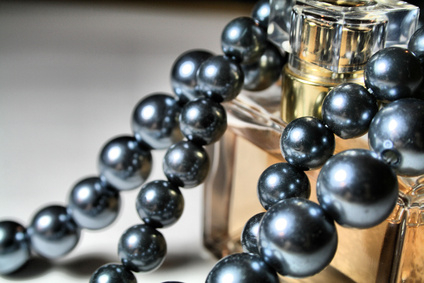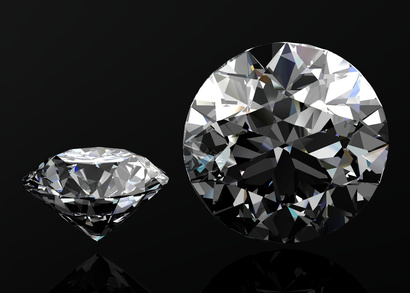You have a gemstone ring that you wear every day, but do you know how you can tell if it needs to be repaired? There are some telltale signs that the prongs of your ring have to be fixed, but most people overlook these clues and unknowingly expose their gemstones to risk.
The First Sign: Does Your Ring Snag?
If you ring catches on your clothes or hair, this may be a sign that something is wrong with your prongs.

If you ring catches on your clothes, something may be wrong with its prongs.
Usually, when prongs are worn, they become thin and their tips get slightly raised above the stone. This is when they may start snagging your clothing.
Don’t ignore this symptom as once a prong is worn out, it is easy for it to break. If that happens, your stone won’t be as tightly held and it may easily fall off the setting.
Don’t Forget to Check for Loose Stones
A giveaway sign that your prongs need fixing is when you notice that your stone moves in its setting. Hitting a prong accidentally can cause it to bend and loosen its grip on your gemstone.
One way to check if your stone is loose is to touch its edge very gently with your finger or fingernail and press lightly against it. You can also use tweezers.
Be careful not to loosen the stone, though. Look for signs of slight movement, and if the stone is even a little loose, you should have your prongs tightened.
Otherwise, the problem may get worse with time, and you risk losing your gemstone down the road.
The Most Common Problems with Prongs
Usually, rings snag because one or more of their prongs are raised, they are bent, or they are worn out.
In any case, you should take off your ring, take a good look at it to diagnose the problem, and have a jeweler fix the piece.
Let’s see what can be done for your prongs in each case.
Raised Prongs
If the prong is a bit raised above your stone and doesn’t lie flat on it, then you have a problem that’s easy to fix.
Usually, prongs that are in such a position weren’t pushed down well enough when the stone was mounted. Or, you bumped your ring somewhere, and the prong got bent.
If your prong doesn’t look thinned out from wear, then the solution is pretty simple. Take your ring to a jeweler, who will simply push the prong down so that it touches and holds the stone.
This might seem easy, but we don’t recommend you to try and fix the issue yourself as you may damage your stone.

Ring with garnet in a prong setting
Thin Prongs
Another common reason that prongs snag is that they are worn out and thin.
In such a case, they become flat, their heads are no longer rounded, and that’s why the prongs catch your clothes or hair easily.
Worn prongs are especially dangerous because they can break, at which point your stone can fall out of the mounting and get damaged or lost.
What’s even worse, all prongs in the same mounting wear equally fast, so if one of them is worn, chances are the others also have gotten thin and pose a risk to your gemstones.
Bent Prongs
Sometimes, prongs bend, and this usually happens when you bump your ring. The problem is that you might not even realize that this happened and your prongs are no longer straight.

The most vulnerable parts of your ring are its prongs.
If one or more of your prongs are broken or bent, some parts of your ring’s gemstone will be exposed to damage, and a stronger bump may cause your stone to chip or crack.
Damaged or misaligned prongs can also cause the stone they are holding to become loose in its setting and even fall out of it.
Why Prongs Bend
Prongs usually bend when you hit your ring, and depending on what metal was used to make them, some prongs are easier to bend than others.
If your setting is made of a softer metal such as gold or silver, your prongs will be at a higher risk of damage.
White gold prongs, which are often used on diamond rings, are more durable: The rhodium plating that gives white gold its color also makes it stronger than yellow gold.
What Are the Signs That My Prongs Are Bent?
One of the best ways to find out if your prongs are bent is to look at the space between them. The gaps between all prongs should be of the same size.
If you notice that your prongs are unevenly spaced, then this is a sign that perhaps one or more of them are not well aligned.
You can also check your prongs for damage using a loupe. If you notice that any of them are out of alignment, lifted slightly above the stone’s surface, or damaged, you should take your ring to a jeweler to have it fixed. Otherwise, you would be putting the safety of your stone at risk.
Even if you cannot see any problems at first glance, it is recommended that you have a jeweler take a look at your setting if you bump your ring really hard. There may be damage that is not immediately obvious, but a professional would most likely be able to spot it.
Note: Looking at the gaps between prongs works best when they are meant to be evenly spaced by design. This is most often the case with settings that hold round-cut stones.
What to Do with My Worn or Bent Prongs?
If you have prongs that are bent out of place, don’t try to realign them yourself – you may damage the gemstone. Take the ring to a jeweler and let a professional take care of the problem.
Usually, this is the easiest issue to fix as the prongs just need to be realigned.
Fixing Thinned and Worn Prongs
If your prongs are worn out, they may need to be rebuilt.
In such a case, the jeweler will add some metal to them in order to strengthen the problematic parts. This procedure is called “retipping” as the additional material will be added to the prong tips that are weakened.
How much the retipping will cost you will depend on the number of prongs that need fixing, the metal used, and the size of the prongs.
If the prongs are too worn out, retipping might not be an option. In such a case, you may need to get an entire new ring head. This would be more expensive than retipping, and the price will depend on the type of mounting your ring has.
In case your prongs are broken, your jeweler will solder new prongs in place. Sometimes, this will be done if your prongs are too worn out to be repaired.
For this procedure, your gemstone will most likely need to be taken off so as not to be damaged in the process.
In any case, you should have your prongs repaired as soon as you notice that something is wrong with them, and you shouldn’t wear your ring until you get it fixed.
Fixing Bent Prongs
If your prongs are bent, the jeweler will realign them so that your stone is held securely.
Don’t forget to ask whoever is doing the repairs to check the entire setting for damage: Sometimes, after a strong hit, the mounting’s body and its prongs may crack, and future problems with your ring would be only a matter of time.
You should also ask the jeweler to check whether your stone is damaged in any way.
You shouldn’t try to straighten the bent prongs yourself as you could easily damage the stone and the setting.
Protecting Prongs from Bending
The best way to avoid bent prongs is, of course, to avoid hitting your ring. To make sure your prongs are also durable, you should pay attention to the material they are made of when buying a new ring.
Softer metals such as gold and silver bend more easily and wear down relatively quickly. White gold is harder and is a good choice if you want prongs that are more robust. Platinum is an even better choice, but it is much more expensive.
Even though platinum and white gold are durable, they cannot guarantee that your prongs won’t bend when hit. You still need to be careful when wearing your ring, check it regularly for bent prongs or other damage, and have it repaired timely if something is wrong.
How Often Should You Inspect Your Prongs?
To make sure that you spot any damage timely, check your prongs at least once every two or three months. It is best to use a loupe to look at your ring setting and see if there are any prongs out of alignment. Also, check if any of your stones are loose.
If you notice any problems such as broken, bent or worn-out prongs, get your ring fixed by a jeweler as soon as possible. Until you do so, you shouldn’t be wearing your ring or you would be at risk of losing your stones.
You should have your rings checked by a professional jeweler at least twice a year. Prongs are the weakest parts of a ring, and the more often you wear it, the faster they will wear out and the more easily they will bend or break.
You can tell if your prongs are worn out by touching them – if they feel flat, they probably need to be rebuilt. The jeweler will inspect your prongs and see if any of them need to be fixed or replaced.
Have Your Ring Professionally Inspected
To make sure you haven’t missed any potential problems with your ring, you can have it checked by a jeweler. In fact, it is good to do so regularly, at least once a year.
If your prongs are bent or worn down, the jeweler will spot these issues pretty quickly, and they can be fixed at the store.














